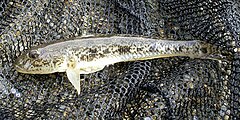Acanthogobius flavimanus
Apariencia
| Acanthogobius flavimanus | ||
|---|---|---|
 | ||
| Taxonomía | ||
| Reino: | Animalia | |
| Filo: | Chordata | |
| Clase: | Actinopterygii | |
| Subclase: | Neopterygii | |
| Infraclase: | Teleostei | |
| Superorden: | Acanthopterygii | |
| Orden: | Perciformes | |
| Familia: | Gobiidae | |
| Género: |
Acanthogobius (Gill, 1859)[1] | |
| Especie: |
A. flavimanus (Temminck & Schlegel, 1845)[2][3] | |
Acanthogobius flavimanus es un género de peces de la familia de los Gobiidae en el orden de los Perciformes.
Morfología
Los machos pueden alcanzar los 30 cm de longitud total.[4][5]
Reproducción
Referencias
- ↑ Gill, T. N., 1859. Notes on a collection of Japanese fishes, made by Dr. J. Morrow. Proc. Acad. Nat. Sci. Phila. v. 11: 144-150.
- ↑ BioLib (en inglés)
- ↑ Temminck, C. J. & H. Schlegel, 1845. Pisces, Fauna Japonica Parts 7-9: 113-172, Pls. 1-143 + A.
- ↑ FishBase (en inglés)
- ↑ Eschmeyer, W.N., E.S. Herald y H. Hammann, 1983. A field guide to Pacific coast fishes of North America. Houghton Mifflin Company, Boston, Estats Units. 336 p.
- ↑ Breder, C.M. y D.E. Rosen, 1966. Modes of reproduction in fishes. T.F.H. Publications, Neptune City, Nova Jersey, Estats Units. 941 p.
Bibliografía
- Anònim, 2000. Base de dades de la col•lecció de peixos del J.L.B. Smith Institute of Ichthyology, Grahamstown, Sud-àfrica. J.L.B. Smith Institute of Ichthyology, Grahamstown, Sud-àfrica.
- Anònim, 2001. Base de dades de la col•lecció de peixos del National Museum of Natural History (Smithsonian Institution). Smithsonian Institution - Division of Fishes.
- Anònim, 2002. Base de dades de la col•lecció de peixos del American Museum of Natural History. American Museum of Natural History, Central Park West , NY 10024-5192, Estats Units.
- Arai, R. y H. Kobayasi, 1973. A chromosome study on thirteen species of Japanese gobiid fishes. Jap. J. Ichthyol. 20(1):1-6.
- Arai, R. y Y. Sawada, 1975. Chromosomes of Japanese gobioid fishes (III) Bull. Natn. Sci. Mus., Ser.A. 1(4):225-232. Tòquio.
- Carlton, J.T., 1985. Transoceanic and interoceanic dispersal of coastal marine organisms: the biology of ballast water. Oceanogr. Mar. Biol. 23:313-371.
- Dôtu, Y. y S. Mito, 1955. On the breeding habits, larvae and young of a goby, Acanthogobius flavimanus (Temminck et Schlegel). Jap. J. Ichthyol. 4(4/5):152-161.
- Eldredge, L.G., 1994. Marine fishes. p. 65-70. A: L.G. Eldredge, Perspectives in aquatic exotic species management in the Pacific Islands. Vol. 1. Introductions of commercially significant aquatic organisms to the Pacific Islands. South Pacific Commission, Nova Caledònia.
- Islam, M.S. y M. Tanaka, 2006. Spatial variability in nursery functions along a temperate estuarine gradient: role of detrital versus algal trophic pathways. Can. J. Fish. Aquat. Sci. 63:1-17.
- Islam, M.S., M. Hibino y M. Tanaka, 2006. Distribution and diets of larval and juvenile fishes: Influence of salinity gradient and turbidity maximum in a temperate estuary in upper Ariake Bay, Japan. Estuarine, Coastal and Shelf Science 68:62-74.
- Islam, M.S., M. Hibino y M. Tanaka, 2006. Tidal and diurnal variations in larval fish abundance in an estuarine inlet in Ariake Bay, Japan: implication for selective tidal stream transport. Ecol. Res.
- Kanou, K., M. Sano y H. Kohno, 2004. Food habits of fishes on unvegetated tidal mudflats in Tokyo Bay, central Japan. Fish. Sci. 70(6):978-987.
- Lever, C., 1996. Naturalized fishes of the world. Academic Press, Califòrnia, els Estats Units. 408 p.
- McDowall, R.M., 1988. Diadromy in fishes: migrations between freshwater and marine environments. Croom Helm, Londres.
- Nelson, J.S., E.J. Crossman, H. Espinosa-Pérez, L.T. Findley, C.R. Gilbert, R.N. Lea y J.D. Williams, 2004. Common and scientific names of fishes from the United States, Canada, and Mexico. American Fisheries Society, Special Publication 29, Bethesda, Maryland, Estats Units.
- Nishikawa, S., K. Amaoka y K. Nakanishi, 1974. A comparative study of chromosomes of twelve species of gobioid fish in Japan. Jap. J. Ichthyol. 21(2):61-71.
- Nogusa, S., 1960. A comparative study of the chromosomes of fishes with particular considerations on taxonomy and evolution. Mem. Hyogo Univ. Agric. 3(1):1-62.
- Riede, K., 2004. Global register of migratory species - from global to regional scales. Final Report of the R&D-Projekt 808 05 081. Federal Agency for Nature Conservation, Bonn, Alemanya. 329 p.
- Robins, C.R., R.M. Bailey, C.E. Bond, J.R. Brooker, E.A. Lachner, R.N. Lea y W.B. Scott, 1980. A list of common and scientific names of fishes from the United States and Canada. Am. Fish. Soc. Spec. Publ. (12)1-174.
- Robins, C.R., R.M. Bailey, C.E. Bond, J.R. Brooker, E.A. Lachner, R.N. Lea y W.B. Scott, 1991. Common and scientific names of fishes from the United States and Canada. Am. Fish. Soc. Spec. Pub. (20):183 p.
- Tamura, E. y Y. Honma, 1977. Histological changes in the organs and tissues of the gobiid fishes throughout their lifespan. VII. Seasonal changes in four species of gobies. Bull. Jap. Soc. Sci. Fish. 43:893-974.
- Vasil'ev, V.P., 1980. Chromosome numbers in fish-like vertebrates and fish. J. Ichthyol. 20(3): 1-38.
- Welcomme, R.L., 1988. International introductions of inland aquatic species. FAO Fish. Tech. Pap. 294. 318 p.
- Wonham, M.J., J.T. Carlton, G.M. Ruiz y L.D. Smith, 2000. Fish and ships: relating dispersal frequency to success in biological invasions. Mar. Biol. 136(6):1111-1121.
- Wu, H.L., K.-T. Shao y C.F. Lai (eds.), 1999. Latin-Chinese dictionary of fishes names. The Sueichan Press, Taiwan.
Enlaces externos
- AQUATAB
- World Register of Marine Species (en inglés)
